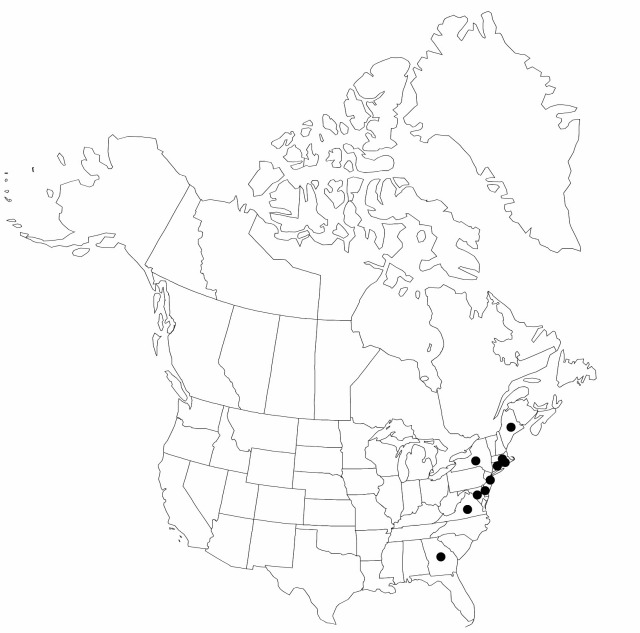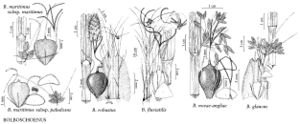Bolboschoenus novae-angliae
Brittonia 47: 434. 1995.
Culms to 150 cm × 5–10 mm. Leaves: sheaths reaching beyond or to middle of culm, fronts convex, papery at mouth, veins reaching apex; widest blade 6–13 mm wide. Inflorescences subumbellate, all or most spikelets solitary or in clusters of 2–7 on 3–11 rays, rays not exceeding 8 cm; involucral bracts that surpass inflorescences 2–4, widest bract 2–8 mm wide. Spikelets 10–40, ovoid or lanceoloid, 15–40 × 5–6(–8) mm; scales tightly appressed or in fruit usually loosely imbricate, medium to dark orange-brown, lineolate-spotted at 15X, 7–9 × 3–4 mm, papery, nearly opaque, apex 2-fid 0.5 mm deep, awn fairly stout, 2–3 × (0.3–)0.5 mm at base. Flowers: perianth bristles weakly attached to shed achene or some to all falling separately, medium brown, 1/2 to equaling length of achene; anthers dark yellow to orange-yellow, 3.5–5 mm; styles (2–)3-fid. Achenes dark to medium brown, color variable often on same achene, shape variable, often in same plant, markedly to obscurely trigonous with equally rounded angles to much compressed-trigonous with abaxial angle broadly rounded, or some biconvex in same spikelet, obovoid, 3–4.3 × 2.3–3.1 mm, apex rounded to nearly truncate, beak 0.1–0.5 mm, surface glossy or glossy with dull patches, entirely clearly cellular at 20X or faintly cellular to noncellular at 30X, often in patches; in cross section exocarp 1/3–2/3 of mesocarp thickness and its cells variably enlarged, 1.5–3 times deeper than wide; achene specific gravity greater to less than water.
Phenology: Fruiting summer.
Habitat: Slightly brackish coastal shores, estuaries, marshes
Elevation: 0 m
Distribution

Conn., Del., Ga., Maine, Md., Mass., N.J., N.Y., R.I., Va.
Discussion
The only Georgia record is the type of Scirpus maritimus [var.] cylindricus Torrey, which lacks locality data. I have not seen a voucher from Georgia or for the only report from North Carolina (E. O. Beal 1977).
In 1913, N. L. Britton and A. Brown treated Bolboschoenus novae-angliae as a species; other authors included it in either Scirpus maritimus or S. robustus until A. E. Schuyler (1975) revived it as a species under the name S. cylindricus (Torrey) Britton [illegitimate, not S. cylindricus (Vahl) Lamarck 1817]. Bolboschoenus novae-angliae is probably of hybrid origin because it is intermediate between B. fluviatilis and B. robustus, especially in its achene structure and perianth bristle persistence (J. Browning et al. 1995), and it is known almost entirely from the zone of sympatry of its putative parents. It is ecologically intermediate between the fresh habitats of B. fluviatilis and the saline habitats of B. maritimus and B. robustus.
Selected References
None.
